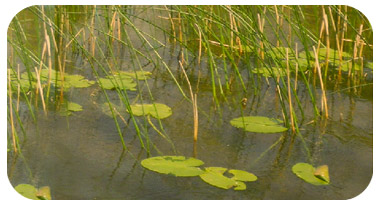The bridle shiner - a species of special concern
You might find this small fish living near you. It needs good quality water and habitat. Learn how to recognize it and help protect it.
How to recognize it: identifying the bridle shiner can be difficult because it is similar to several shiner species. Furthermore, the black lateral band that characterizes it can be less visible.
The Species at Risk Act (SARA) was created in order to prevent wildlife species in Canada from becoming extinct, to provide for the recovery of species at risk and to manage species of special concern. A management plan must be developed for species of special concern such as the bridle shiner. The plan includes the measures required to conserve the species and its habitat.
Quebec Distribution
Bridle shiners can be found in the St. Lawrence River upstream of Québec and in the lakes and streams of the St. Lawrence River lowlands.
Where to find them?
Bridle shiners live in areas of streams and lakes where there is plenty of aquatic vegetation. There they can feed, hide from predators and spawn. They prefer waterbeds of sand, silt or organic debris, and thrive in water that is relatively warm and clear.
A natural shoreline is key to a healthy stream or lake, because it keeps the temperature cool and oxygen levels up, and it provides food and cover. It also serves as a protective barrier to pollutants and a natural protection against shoreline erosion.
Threats
A number of human activities (farming, urban, forestry and recreational) can cause loss or degradation of the habitat of bridle shiners. Some of the main threats to the habitat of this species at risk are:
- reduced water quality due to chemicals, sediments and fertilizers,
- the removal or degradation of aquatic or shoreline vegetation,
- fluctuating water levels, and
- the disruption of natural water flow patterns, or barriers to the free passage of fish.
In addition, the use of the bridle shiner as a baitfish by recreational fishers can also constitute a threat to this species and hinder its conservation.
Recovery
The Habitat Stewardship Program for Species at Risk and the Aboriginal Funds for Species at Risk help fund recovery and awareness projects. For example, shorelines have been planted with vegetation to stabilize them and to restore the aquatic habitat.
A management plan for the bridle shiner has also been developed. It makes a synthesis of current knowledge, identifies threats to the species and its habitat and recommends measures to maintain and increase bridle shiner populations.
You have a role to play
Waterfront residents: avoid disturbing the bridle shiner's habitat
- Preserve or restore natural aquatic and shoreline vegetation.
- Avoid driving vehicles on streambeds or shorelines.
- Avoid spreading fertilizer or pesticides.
Fishers: do not use bridle shiners as baitfish
- Learn how to recognize this species of special concern.
- If you catch an bridle shiner by accident, return the fish to the water immediately to give it the best possible chance of surviving.
To find out more

Picture : L. Bernatchez and M. Giroux 2000
Les Poissons d'eau douce du Québec et leur répartition dans l'est du Canada. Éditions Broquet. 350 p.

Illustration : E. Edmonson (New York State Department of Environmental Conservation)

Bridle shiners can be found in the St. Lawrence River upstream of Québec and in the lakes and streams of the St. Lawrence River lowlands.

A natural shoreline
Fisheries and Oceans Canada, C. Tremblay

Fisheries and Oceans Canada, P. Nilo
- Date modified: